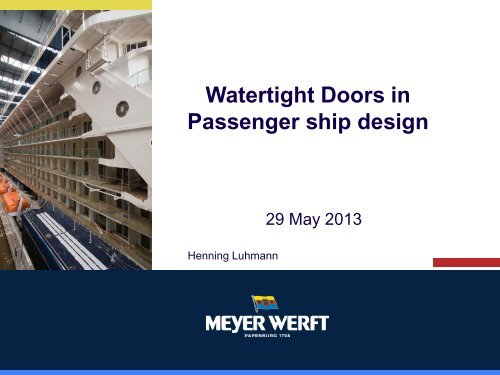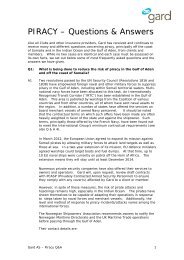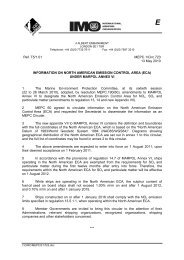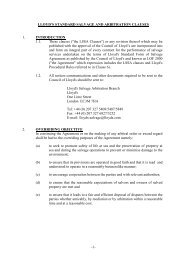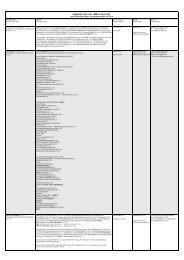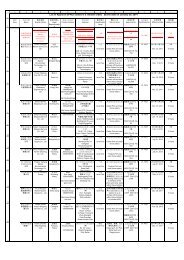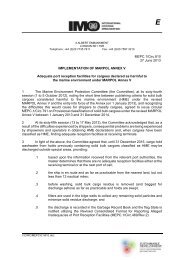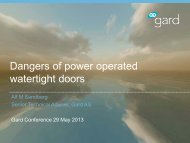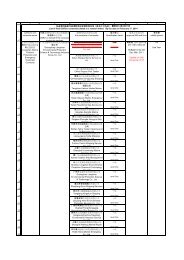Watertight Doors in Passenger ship design - Gard
Watertight Doors in Passenger ship design - Gard
Watertight Doors in Passenger ship design - Gard
You also want an ePaper? Increase the reach of your titles
YUMPU automatically turns print PDFs into web optimized ePapers that Google loves.
1<br />
<strong>Watertight</strong> <strong>Doors</strong> <strong>in</strong><br />
<strong>Passenger</strong> <strong>ship</strong> <strong>design</strong><br />
ty<br />
29 May 2013<br />
Henn<strong>in</strong>g Luhmann<br />
WTD Workshop Arendal<br />
29 May 2013
Meyer Werft<br />
2<br />
• Founded <strong>in</strong> 1795<br />
• 100% family owned<br />
• 2 locations – 1 <strong>ship</strong>yard<br />
• Meyer Werft <strong>in</strong> Papenburg<br />
• Neptun Werft <strong>in</strong> Rostock<br />
– 11 production halls<br />
• 2 covered build<strong>in</strong>g docks<br />
• 4 halls for unit and pipe<br />
production<br />
• 5 halls for laser weld<strong>in</strong>g and<br />
flow l<strong>in</strong>e for block production<br />
– Largest covered<br />
<strong>ship</strong>build<strong>in</strong>g hall <strong>in</strong><br />
the world (504 m x 125 m)<br />
– Europe's largest laser<br />
centre<br />
– Crane capacity of up to<br />
800 t per crane<br />
– Own cab<strong>in</strong> production
Product Portfolio 3<br />
Cruise <strong>ship</strong>s<br />
River cruise <strong>ship</strong>s<br />
Research <strong>ship</strong>s<br />
Ships: 36 (+5) Ships: 27 (+15) Ships: 0 (+1)<br />
Gas tankers<br />
Island ferries<br />
Ferries / Cruise ferries<br />
Ships: 56 Ships: 29 Ships : 32<br />
<strong>Passenger</strong> <strong>ship</strong>s<br />
Livestock carriers<br />
Conta<strong>in</strong>er <strong>ship</strong>s<br />
Ships: 24 Ships: 27 Ships: 4
Orderbook<br />
Meyer Werft, Papenburg<br />
Neptun Werft, Rostock<br />
4<br />
Norwegian Cruise L<strong>in</strong>e<br />
Norwegian Getaway<br />
2014<br />
Royal Carribean<br />
International<br />
Quantum of the Seas 2014<br />
Anthem of the Seas 2015<br />
Research <strong>ship</strong><br />
Sonne delivery 2015<br />
© 2008 Meyer Werft GmbH<br />
Norwegian Cruise L<strong>in</strong>e<br />
S. 693 delivery 2015<br />
S. 694 delivery 2017<br />
16 River cruise vessels<br />
delivery until 2014
15 years – 11 prototypes 5<br />
2000 – Aurora 76,000 GT Purpose-built for British market<br />
2001 – Radiance o/t Seas 90,000 GT Gas turb<strong>in</strong>e & pod propulsion<br />
2001 – Norwegian Star 92,000 GT Freestyle <strong>design</strong><br />
2004 – Pont-Aven 41,000 GT High-speed cruise ferry<br />
2005 – Norwegian Jewel 93,500 GT Largest panmax <strong>design</strong><br />
2007 – AIDAdiva 68,500 GT Compact „Club“ <strong>design</strong><br />
2008 – Celebrity Solstice 122,000 GT 1 st <strong>ship</strong> with 1000+ balcony cab<strong>in</strong>s<br />
2010 – Disney Dream 130,000 GT Surprise for the <strong>in</strong>dustry<br />
2013 – NCL Breakaway 146,600 GT Optimized <strong>in</strong>dustrialized <strong>design</strong><br />
2014 – Quantum o/t Seas 167,000 GT Energy sav<strong>in</strong>g as a key element<br />
2015 – NCL Breakaway Plus 163,000 GT Evolution of Breakaway
Introduction<br />
6<br />
• To achieve a good safety level a careful balance is needed<br />
Regulations<br />
Safety<br />
Design<br />
Operation<br />
WTD Workshop Arendal<br />
29 May 2013
Damage Stability<br />
7<br />
• Internal watertight <strong>in</strong>tegrity requires high attention<br />
• Operation of water tight doors<br />
• Rout<strong>in</strong>g of pipes and ducts<br />
• Bulkhead penetrations<br />
• Up to 100 different systems need to be controlled<br />
dur<strong>in</strong>g <strong>design</strong> and production<br />
WTD Workshop Arendal<br />
29 May 2013
Types of watertight doors<br />
8<br />
• Different type of doors used<br />
– Normal WTD below bulkhead deck<br />
– Light WTD with reduced scantl<strong>in</strong>gs, otherwise like normal WTD<br />
– Semi-watertight doors: to be used with GZ range only, not below<br />
immersion l<strong>in</strong>e<br />
– Fire doors<br />
• Use of doors dur<strong>in</strong>g navigation may be different<br />
– WTD always closed<br />
– Semi-WTD and fire doors may be kept open<br />
WTD Workshop Arendal<br />
29 May 2013<br />
7 February 2012 Public Workshop Hels<strong>in</strong>ki 8
Design assumption<br />
9<br />
• All damage stability calculations are based on closed water tight doors<br />
• Operational needs are not considered carefully dur<strong>in</strong>g <strong>design</strong> <strong>in</strong> the past<br />
• Layout of the vessel may be <strong>in</strong> conflict with operational needs<br />
• Many <strong>ship</strong>s have exemptions to have WTDs open dur<strong>in</strong>g navigation<br />
Many 3-zone<br />
damages<br />
are not<br />
survivable<br />
WTD Workshop Arendal<br />
29 May 2013
GA with marked WTD<br />
10<br />
WTD Workshop Arendal<br />
29 May 2013<br />
7 February 2012 Public Workshop Hels<strong>in</strong>ki 10
Purpose of WTD<br />
11<br />
• Why are <strong>ship</strong>s built with watertight doors<br />
effective use of the available space<br />
• 2 nd means of escape<br />
• Avoid<strong>in</strong>g dead-end corridors<br />
• Used for transport of goods<br />
• Ma<strong>in</strong>tenance and transport of spare parts<br />
WTD Workshop Arendal<br />
29 May 2013
Examples of use of WTD<br />
12<br />
2 nd means of escape<br />
Dead-end<br />
Avoid<strong>in</strong>g dead-end corridors<br />
Staircase<br />
Used for transport of goods<br />
2nd escape<br />
Cold rooms<br />
Service lift<br />
Laundry<br />
L<strong>in</strong>en stores<br />
WTD Workshop Arendal<br />
29 May 2013
Examples of use of WTD<br />
13<br />
Ma<strong>in</strong>tenance and transport of spare parts<br />
easy connection of eng<strong>in</strong>e rooms is desired by many chief eng<strong>in</strong>eers<br />
Ships have been <strong>design</strong>ed <strong>in</strong> the past without the right balance between daily<br />
operation and damage stability<br />
WTD Workshop Arendal<br />
29 May 2013
Evacuation<br />
14<br />
• Evacuation has a high priority <strong>in</strong> <strong>ship</strong> <strong>design</strong><br />
• Each ma<strong>in</strong> vertical zone has a well protected staircase<br />
lead<strong>in</strong>g to the life boat deck and assembly stations<br />
• Each watertight compartment has a vertical escape to<br />
the boat deck <strong>in</strong>side a protected stair case<br />
• Each space requires 2 <strong>in</strong>dependent means of escape<br />
evacuation deck<br />
WTD Workshop Arendal<br />
29 May 2013
Design to keep WTD closed<br />
15<br />
• Design can be adapted to keep WTDs closed<br />
• To be considered at an early <strong>design</strong> stage<br />
• Survivability (atta<strong>in</strong>ed <strong>in</strong>dex A) may be reduced<br />
• Example “Laundry” <strong>in</strong> larger compartment:<br />
WTD Workshop Arendal<br />
29 May 2013
Design to keep WTD closed<br />
16<br />
• Other examples<br />
Laundry arrangement on<br />
two decks<br />
In one compartment<br />
Workshops <strong>in</strong> one compartment<br />
Multiple lifts to access provision rooms<br />
WTD Workshop Arendal<br />
29 May 2013
Design to m<strong>in</strong>imize WTD<br />
17<br />
• Optimized cab<strong>in</strong> arrangement to m<strong>in</strong>imize the number of doors<br />
Six WTD <strong>in</strong> 2 compartments<br />
One WTD <strong>in</strong> 2 compartments<br />
WTD Workshop Arendal<br />
29 May 2013
<strong>Doors</strong> on bulkhead deck<br />
18<br />
• Layout of bulkhead deck to meet many different requirements<br />
– Subdivision with partial bulkheads<br />
– Escape from watertight compartments<br />
– Longitud<strong>in</strong>al corridor for crew and goods<br />
– Control stations<br />
WTD Workshop Arendal<br />
29 May 2013
<strong>Doors</strong> on bulkhead deck<br />
19<br />
• Use of fire doors <strong>in</strong> way of central corridor<br />
• Fire doors susta<strong>in</strong> 2.5m water level with only small<br />
leakage<br />
• May be used to restrict progressive flood<strong>in</strong>g on bulkhead<br />
deck<br />
• Improves subdivision without the underm<strong>in</strong><strong>in</strong>g overall risk<br />
– Fire doors may be used <strong>in</strong> escape ways<br />
– No risk for <strong>in</strong>juries like for WTD<br />
WTD Workshop Arendal<br />
29 May 2013
Categories of doors<br />
20<br />
• MSC Circ 1380 def<strong>in</strong>es different categories of doors<br />
• The categories need to be discussed, but<br />
• <strong>Doors</strong> may have significantly different <strong>in</strong>fluence on<br />
survivability<br />
• Acceptance to use water tight doors should reflect the<br />
<strong>in</strong>fluence on survivability<br />
Influence of a s<strong>in</strong>gle open<br />
WTD on A-<strong>in</strong>dex<br />
WTD Workshop Arendal<br />
29 May 2013
Categories of doors<br />
21<br />
• Design should be optimized to m<strong>in</strong>imize the <strong>in</strong>fluence of open water tight<br />
doors<br />
• Number of doors to be further reduced<br />
• Latest <strong>design</strong>s show equal vulnerability for open water tight doors<br />
Influence of a s<strong>in</strong>gle<br />
open WTD on A-<strong>in</strong>dex<br />
Influence of open WTD on vulnerability<br />
WTD Workshop Arendal<br />
29 May 2013
Operation<br />
22<br />
• Design and operation need to be aligned from early <strong>design</strong><br />
• All damage stability calculations assume all WTD closed<br />
• Operation may require the connection between certa<strong>in</strong> spaces<br />
• Risk for <strong>in</strong>juries for crew and passengers is very high dur<strong>in</strong>g clos<strong>in</strong>g of WTD<br />
• Good example for a possible balanced approach between stakeholders<br />
• Designers: <strong>design</strong> subdivision follow<strong>in</strong>g operational needs<br />
• Operators. Cooperate <strong>in</strong> early <strong>design</strong> stage, change traditional procedures to<br />
ma<strong>in</strong>ta<strong>in</strong> watertight <strong>in</strong>tegrity<br />
• Academia: provide methods and tools to keep crew alerted<br />
• Regulators: force all <strong>design</strong>ers and operators to keep doors closed for new <strong>ship</strong>s<br />
WTD Workshop Arendal<br />
29 May 2013
Conclusion<br />
23<br />
• Safety is one of the key objectives of passenger <strong>ship</strong> <strong>design</strong><br />
• <strong>Watertight</strong> doors are a vital component to achieve the desired<br />
survivability<br />
• The cruise <strong>ship</strong> <strong>in</strong>dustry works pro-active<br />
• Safety levels need to be cont<strong>in</strong>uously reviewed and adjusted if needed<br />
• Only with close cooperation between operators, <strong>ship</strong>yards and<br />
adm<strong>in</strong>istrations the good safety record can be further improved<br />
WTD Workshop Arendal<br />
29 May 2013


